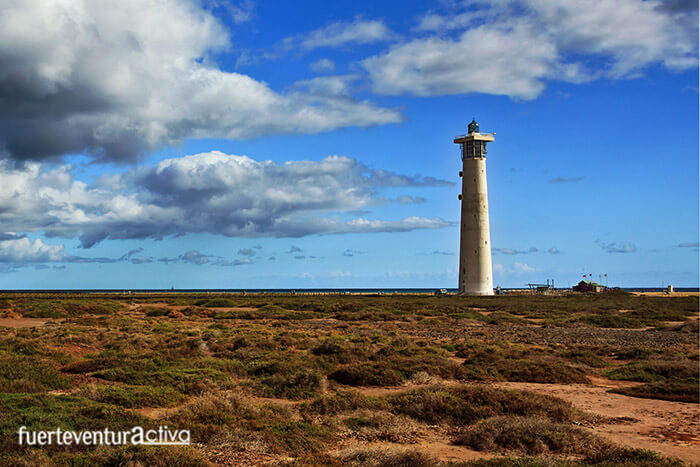Fuerteventura beaches, What to see in Fuerteventura ?
What to visit in Morro Jable?
The town of Morro Jable, in the south of Fuerteventura, has become one of the most important tourist landmarks on the island. The main reason is its extensive beaches of fine sand and transparent waters. The beautiful natural landscapes that surround this enclave also contribute to thousands of tourists choosing Morrojable as their vacation destination.
The origins of Morro Jable as a permanent settlement date back to the end of the 19th century, when Cirilo López Umpiérrez, the first inhabitant of the area, established his residence here. Cirilo arrived in Morro Jable fleeing the war in Cuba and decided to build a shack-house at the mouth of the Siervo valley, next to the beach. Little by little, more families from Cofete, the north of Fuerteventura and Lanzarote joined. At that time, the economic engine of Morro Jable was fishing, agriculture and goat farming.

We could say that Morro Jable is currently divided into three well-differentiated areas. One is the seaport, where the ferries from Gran Canaria arrive; another is the historic center of the town, which takes place in the course of the Siervo ravine; the third is the Matorral beach and everything that is behind it. In this last area is where there is a greater concentration of hotels.
5 Places you cannot miss on a visit to Morro Jable
1 – Stroll through the historic center
The historic center of Morro Jable is characterized by its narrow and steep streets. Walking through them you will see bronze sculptures that pay homage to beloved local characters such as Cirilo López, Willy Brandt, Juan Placeres and Andrés Hierro “El Rubio”, among others. There are also sculptures dedicated to anonymous characters but just as important as they were. fishermen, goatherds and people of the sea.

On the escarpment that rises next to the sea is the new Church of Nuestra Señora del Carmen. The extraordinary views that you can enjoy from this enclave make it one of the most spectacular viewpoints in the town. From here you can see both the wide beaches and its seaport.
Under the escarpment and next to the beach is Avenida Tomás Grau Gurrea. Here is the largest concentration of restaurants in the town where you can savor from typical Canarian dishes and fresh fish, to a wide and varied international menu adapted to the profile of the tourist.
A little further on is the town’s first church, built in the mid-20th century. It was used for a time as a school.

It is noteworthy that in the past, a unique bell was installed in the square, known by all as “La Campana de Cofete”, which was found in a maritime buoy from the Florida coast, which the Gulf currents carried to the beach. of coffee.
2 – La Cebada beach

La Cebada Beach is located in the historic center of Morro Jable. It is the cove between the mouth of the Siervo ravine and Punta de Morro Jable. It has fine golden sand, with turquoise waters, ideal for practicing water sports. It is also a wonderful place to spend the day with family and friends, enjoying the waves and the sand. This beach was, for centuries, one of the most important ports in Fuerteventura. From here tons of cereal and stone were shipped
3 – Beaches of El Matorral and Morro Jable

The beaches of El Matorral and Morro Jable are naturally linked, forming one of the largest tourist beaches in Fuerteventura. More than 4.5 kilometers long and 60 meters wide to enjoy long walks.
The lighthouse, visible from the entire beach, serves both as a maritime signal for ships and as a dividing line between the nudist beach to the north of the lighthouse and the non-nudist beach to the south.
4 – Jandía salt marsh.

The Jandía Wetland is a Site of Scientific Interest. It is located behind the Matorral beach. It is the only wetland in the Canary Islands integrated into the Ramsar network, an intergovernmental treaty that serves as a framework for the conservation of wetlands and their resources. The salt marsh stands out for the richness of its flora and for being a landfall area for seabirds, which give it a high scientific value.
This natural space has an extensive plant community where sea gooseberries, matomoros, salados and balancones abound, among other species. Two endemic species of reptiles also inhabit it: the Atlantic lizard and the perenquén. If you like bird watching, bring your binoculars. A good variety of wading birds and Canary stonechats nest in the Jandía salt marsh
5 – Old Matorral Salt Flats

The Salinas del Matorral are located to the left of the lighthouse. One of the structures that served to pump seawater inland is still visible. These salt flats were built in the 1930s and were in operation until 1950, when Gustav Winter acquired the property. Gustav Winter’s idea was to set up a canning and fishmeal factory in the area. To materialize this project he had a small fleet of eleven fishing boats, which he had bought in France.
El Matorral salt flats produced salt all year round, reaching three hundred tons per year, which was exported to Tenerife and Gran Canaria through the Port of La Cebada.
We do not want to end this article without mentioning the origin of the place name of Morro del Jable. The name was given by the Franco-Norman conquerors in the fifteenth century, and the place name has remained on the island ever since. It is an adaptation of the French word “sable” (sand) together with “morro” which is a point elevation of bare basalt rock and which generally arises from the erosion of hilly reliefs.
Fuerteventura4 Fuerteventura1




